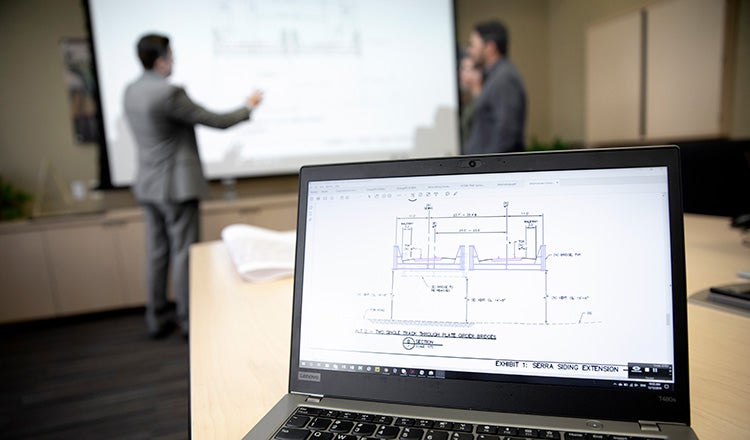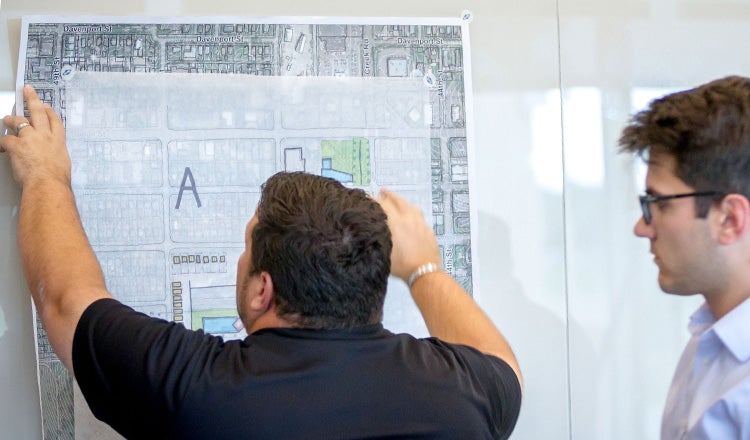
Experts Talk: Addressing Transportation Agency Workforce Challenges Through Staff Augmentation with Brian Blanchard
Experts Talk is an interview series with technical leaders from across our transportation program.
Strategies for Success in Supplementing Public Staff With Private Consultants
Transportation agencies across North America have long tried to find the best approach to navigate an environment of increased workload and dwindling staff. Planning, design and program management services have developed into a substantial component of the professional services procured by departments of transportation and other transportation agencies.

Principal consultant Brian Blanchard has more than 40 years of experience in the transportation industry, including more than three decades in leadership positions at the Florida Department of Transportation, last serving as assistant secretary. In that time, he has gathered significant experience in staff augmentation and supporting projects through various contracting approaches. With his experience as an agency executive, he advises our transportation clients on the best techniques and methods to reach their program goals. In this interview he discusses why staff augmentation is needed now more than ever, the benefits it can bring, contract considerations and what to expect when adding embedded consultant staff.
Q. How are the workforce trends in the infrastructure industry affecting transportation agencies in particular?
A. Many of the workforce trends we’ve seen playing out recently across industries have also affected public transportation agencies. Baby boomers are retiring in greater numbers, newer employees are becoming harder to find, jobs are becoming more specialized, and workers are asking for more flexibility such as the ability to work from home. All of this creates challenges in staff retention and development and an ongoing reduction in many public agency workforces. At the Florida Department of Transportation, for instance, the number of employees has dropped from about 12,000 employees in 1988 to half that today, even as the agency’s work program has grown by a factor of 10.
An added pressure in transportation in the U.S. has been the recent rapid growth in state and local highway programs, prompted in particular by the 2021 Infrastructure Investment and Jobs Act. The IIJA provided states with more than $550 billion for new investments for FY 2022 through FY 2026, which is welcome but also means finding the staff to complete the new projects is a high-priority concern for many agencies.

Q. How have agencies sought to address this current reality? How can private consultants like HDR help?
A. Faced with many projects to complete and fewer staff with which to do it, many agencies have expanded their staff augmentation for project development functions such as planning, program management, design and more. Research published in 2021 by Clemson University included a survey of U.S. departments of transportation that found across the nation, agencies contracted an average of 54% of preconstruction design and engineering to private consultants. This doesn’t even include services provided during and after construction, such as construction management, inspections, contract administration and more.
Just as every agency’s needs are different, there’s no standard approach to staff augmentation. Some have contracted out a large portion of their work through broad general engineering consultant contracts that may cover almost everything they do. This is the case at Florida DOT, for which HDR has provided engineering services for decades. In some cases, these agencies may retain just a small core staff to administer and support oversight of these GEC contracts. Other agencies use GEC contracts for specific statewide services or individual programs, such as the Council Bluffs Interstate System being completed by Iowa DOT or the long-term capital improvement program at Jacksonville Port Authority.
Indefinite delivery/indefinite quantity contracts, or IDIQ, are also an option. These involve the performance of services under task or work orders issued on an as-needed or on-call basis, for an established contract period. In general, IDIQ contracts are smaller and less complex than a GEC option.
Any of these approaches can be valid and scalable. What’s important is understanding the priorities of the agency and the implications of their choice. For example, while the flexibility of a broad GEC contract can be appealing, it’s important to note that if any federal funds are involved, a specific scope of work, method of payment, and a detailed cost estimate including labour costs must be clearly defined in the contract.
Q. How has client staff augmentation become a key strategy for ensuring high-quality expertise on complex programs?
A. It’s not just a shortage in the number of staff that transportation agencies are facing, it’s also a shortage of expertise. As our transportation system has become more complex, much of the work has become more specialized. Experts with experience in the latest Intelligent Transportation Systems, design software or equity-focused planning practices are in high demand. In many cases, private consultants offer specialized expertise that cannot be found at public agencies. These insights can be particularly valuable on projects dealing with emerging technology, sustainability, broadband, new alternative delivery methods or other areas where agencies may not have a long history but which are major focuses of current federal funding.
Capacity constraints can limit agency abilities, while consultants often have more flexibility to respond quickly to fast-track scheduling needs. Large private consultants also help spread industry best practices, applying knowledge learned from one agency to projects at another. And within an agency they can help transfer knowledge about ongoing agency activities, particularly useful on long-term programs where turnover or attrition require new agency staff to take over from departing colleagues.

Q. What should agencies expect and plan for when using embedded private staff?
A. As agencies use private consultants to augment programmatic delivery needs, this added staff is often embedded in public offices. This can create great opportunities for collaboration and communication, but the arrangement also brings with it some unique considerations.
Any embedded employees need to understand how policies may differ depending on their location or client organizational structure. For example, consultant staff may need to undergo added mandatory training if they will be using agency computers or phones subject to public records requests or government cybersecurity regulations. Similarly, staff driving agency vehicles will require specific safety training.
Additionally, long-term, full-time consultants’ overhead rate should match their situation. If consultants are sitting in a government building for an extended period and using those offices rather than maintaining their own, their overhead rate should parallel the arrangement.
A good rule of thumb is to be as clear as possible about roles, so all involved understand roles and responsibilities — what the consultant is working on, what the public employee is working on, and how they should work together. As in any office, maintaining that relationship is important to ensuring an effective and efficient team.
Q. As transportation agencies look to the future, what should they expect when it comes to workforce challenges and how can they be proactive in preparing for them?
A. The workforce picture doesn’t seem poised to change anytime soon, and there will be a tight labour market for the foreseeable future. A recent letter from the American Council of Engineering Companies to President Biden noted that the engineering workforce was at full employment even before the passage of the IIJA and other federal funding influxes. Competition for top talent will remain high.
Transportation agencies today will be forced to make significant adjustments as financial resources become unpredictable, career employees retire or leave, and technology reliance increases. These changes will continue to shift agencies’ business landscape. External forces, including technology advancements, legislative requirements and changing public expectations will force DOTs to reexamine their organizations and role in delivering infrastructure solutions. Strategic partnerships provide opportunities to achieve more than is possible for an individual agency working in isolation. By actively managing partnerships among public agencies and with the private sector, transportation agencies can potentially achieve greater outcomes with the same resources.
Thankfully, there is help available to agencies as they navigate these changes. Our principal consultants, part of our Infrastructure Advisory Services, focus on helping agencies through major transitions or concerns such as these. They listen, inquire and interpret challenges, then use their decades of experience, knowledge of program funding strategies and capital program development to propose approaches to address challenges. When it comes to workforce challenges, those organizational management strategies could include strategic planning, organizational restructuring and process improvements, all designed to make agencies agile and resilient in meeting their performance goals.
Each Experts Talk interview illuminates a different aspect of transportation infrastructure planning, design and delivery. Check back regularly to discover new insights from the specialized experts and thought leaders behind our award-winning, full service consulting practice.


